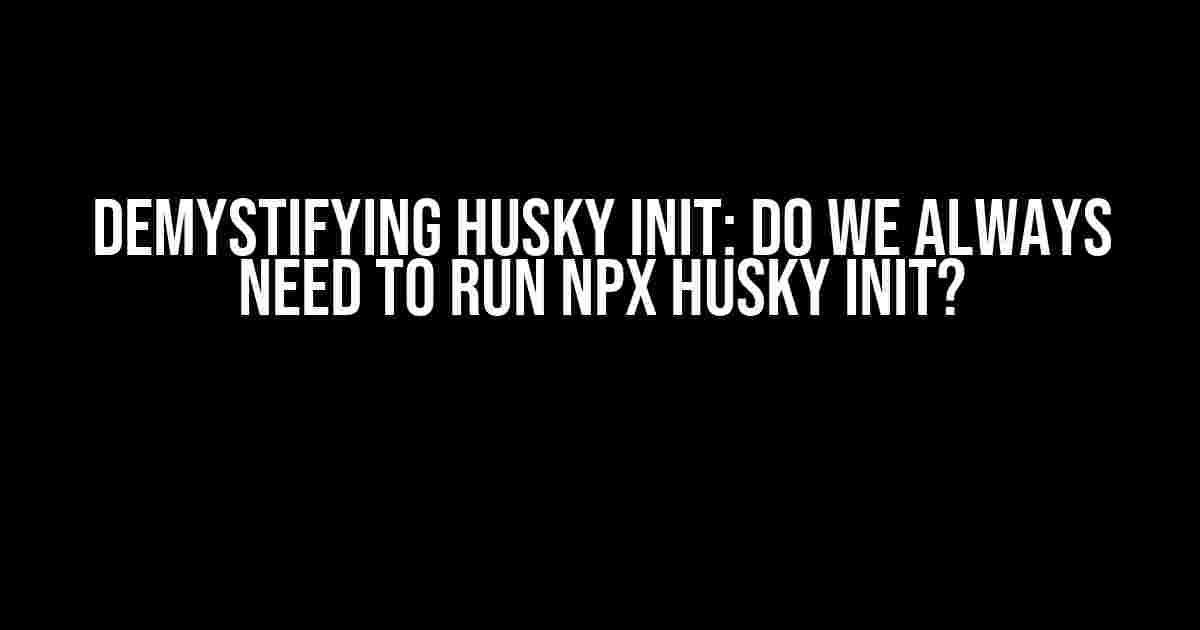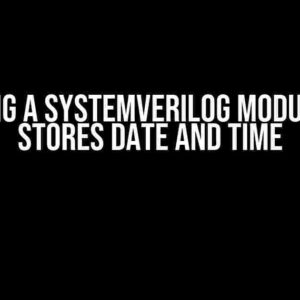Are you tired of wrestling with Husky hooks, wondering why they just won’t work as expected? You’re not alone! One of the most common questions in the Husky community is whether we always need to run npx husky init after installing Husky to get the hooks to work. In this article, we’ll delve into the world of Husky init, explore the reasons behind this requirement, and provide you with a clear understanding of when and why you need to run this command.
What is Husky?
Before we dive into the nitty-gritty of Husky init, let’s quickly cover what Husky is and why it’s an essential tool in modern development workflows.
Husky is a popular, open-source tool that helps you manage and configure Git hooks for your projects. Git hooks are scripts that run at specific points in the Git workflow, such as before committing code or pushing changes to a remote repository. These hooks can be used to enforce coding standards, run tests, and even automate tasks like formatting code or updating dependencies.
Why Do We Need to Run npx husky init?
So, why do we need to run npx husky init in the first place? The answer lies in how Husky works under the hood.
When you install Husky using npm or yarn, the package manager only installs the Husky binaries and configuration files. However, for Husky to function correctly, it needs to create a special `.husky` directory in your project’s root, which contains the actual hook scripts.
The npx husky init command takes care of creating this directory and setting up the necessary hook scripts. It also generates a `.huskyrc` file, which stores the configuration for your Husky setup.
Without running npx husky init, Husky won’t be able to find the hook scripts, and your Git hooks won’t work as expected. This is why it’s essential to run this command after installing Husky.
When Do We Need to Run npx husky init?
Now that we understand why we need to run npx husky init, let’s explore when we need to run this command.
There are three common scenarios where you’ll need to run npx husky init:
- After installing Husky for the first time: When you install Husky using npm or yarn, you’ll need to run
npx husky initto set up the initial configuration and hook scripts. - After updating Husky to a new version: If you update Husky to a new version, you might need to run
npx husky initagain to ensure that the new version is properly configured. - After migrating to a new project structure: If you change your project’s directory structure or move the `.husky` directory, you’ll need to run
npx husky initagain to update the hook scripts and configuration.
In general, it’s a good idea to run npx husky init whenever you make significant changes to your project’s structure or Husky configuration.
What Happens If We Don’t Run npx husky init?
So, what happens if we don’t run npx husky init after installing Husky? Well, you might encounter some issues with your Git hooks.
Here are some common problems you might face:
- Git hooks don’t run: Without the `.husky` directory and hook scripts, your Git hooks won’t run as expected.
- Error messages and warnings: You might see error messages or warnings when trying to commit code or push changes to a remote repository.
- Inconsistent behavior: Without a properly configured Husky setup, your Git hooks might behave erratically or produce unexpected results.
To avoid these issues, it’s essential to run npx husky init after installing Husky and whenever you make significant changes to your project’s structure or Husky configuration.
Best Practices for Using Husky
To get the most out of Husky and avoid common issues, follow these best practices:
- Run
npx husky initafter installing Husky: This ensures that your Husky setup is properly configured and ready to use. - Use a consistent project structure: Try to maintain a consistent project structure to avoid issues with Husky and other development tools.
- Keep your Husky configuration up-to-date: Regularly review and update your Husky configuration to ensure it aligns with your project’s needs.
- Test your Git hooks regularly: Verify that your Git hooks are working correctly by testing them regularly.
Conclusion
In conclusion, running npx husky init is an essential step in configuring Husky for your project. By understanding why and when we need to run this command, we can ensure that our Git hooks work correctly and our development workflow runs smoothly.
Remember, it’s always a good idea to run npx husky init after installing Husky, updating to a new version, or making significant changes to your project’s structure. By following best practices and staying consistent, you’ll be able to harness the full power of Husky and take your development workflow to the next level.
| Scenario | Do we need to run npx husky init? |
|---|---|
| After installing Husky for the first time | Yes |
| After updating Husky to a new version | Maybe (depending on the version update) |
| After migrating to a new project structure | Yes |
npx husky init
Run this command to set up your Husky configuration and hook scripts.
Frequently Asked Question
Get the lowdown on Husky init and hookups!
Do I really need to run npx husky init every time I install Husky?
The short answer is yes! Running npx husky init is a one-time setup process that enables Husky to work its magic. It creates the necessary configuration files and hooks in your Git repository. Without it, Husky won’t be able to operate correctly.
What happens if I forget to run npx husky init?
Don’t worry, it’s not the end of the world! If you forget to run npx husky init, Husky simply won’t work. You might notice that your Git hooks aren’t being triggered, and you won’t get the benefits of Husky’s automation. Just run the command, and you’ll be good to go!
Can I skip running npx husky init if I’ve already set up Husky before?
If you’ve previously set up Husky in your project, you don’t need to run npx husky init again. Husky will pick up where it left off, and your hooks will continue to work as expected. However, if you’ve made changes to your Git repository or Husky configuration, running npx husky init again can ensure everything is up-to-date and properly configured.
Will running npx husky init affect my existing Git hooks?
Rest easy! Running npx husky init won’t overwrite or delete your existing Git hooks. Instead, it will create a new configuration file that integrates with your existing hooks. If you’ve already set up custom hooks, they’ll continue to work alongside Husky’s automation.
Can I automate running npx husky init in my project?
You’re thinking like a pro! Yes, you can automate running npx husky init by adding it to your project’s scripts in the package.json file. This way, whenever someone installs your project, Husky will be initialized automatically, ensuring that everyone gets the benefits of Husky’s automation.



